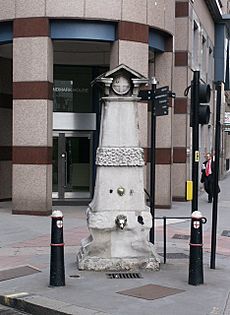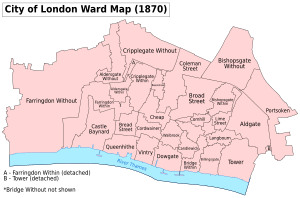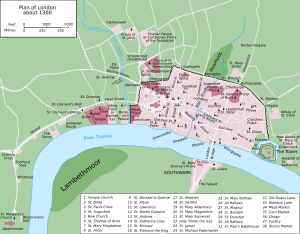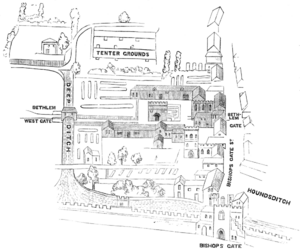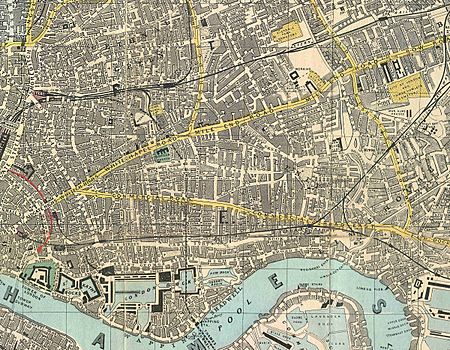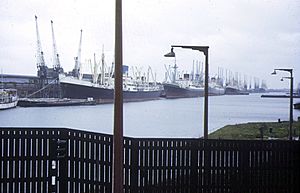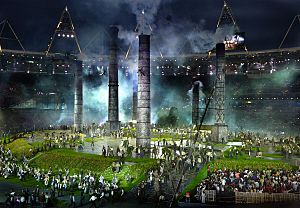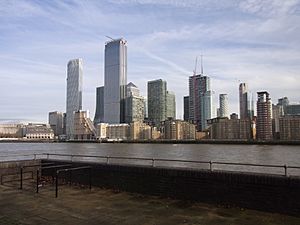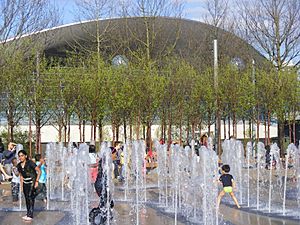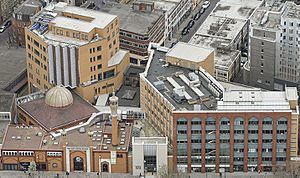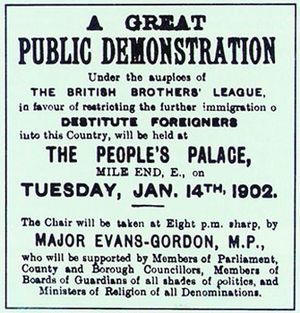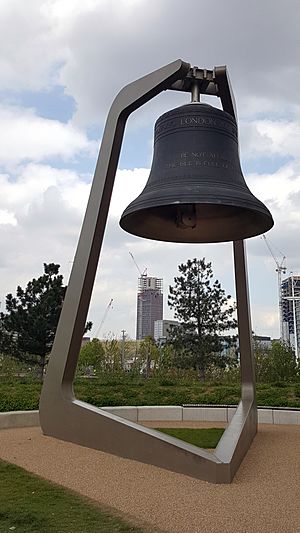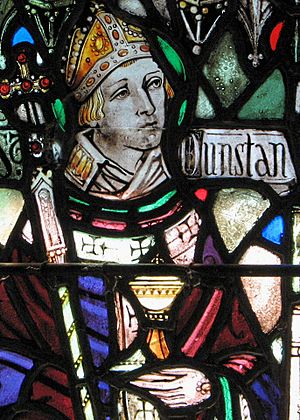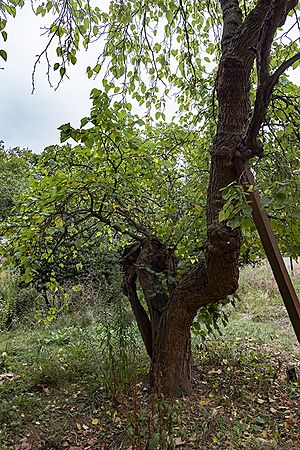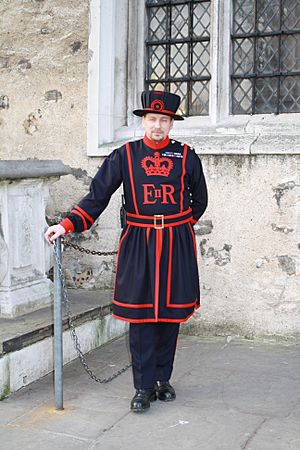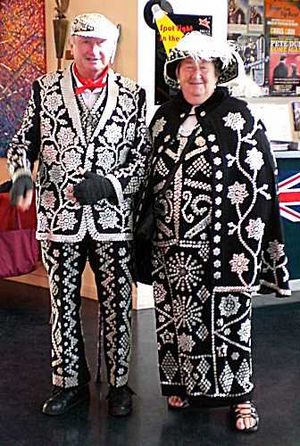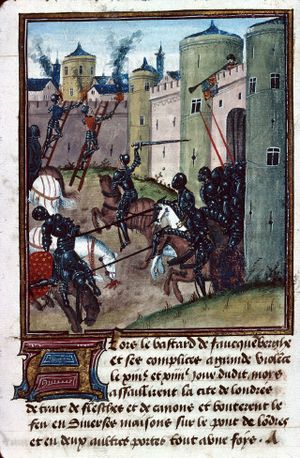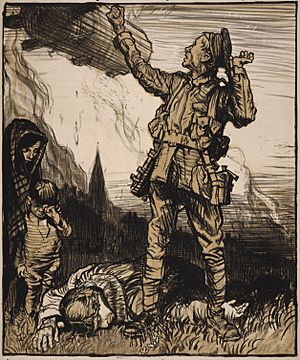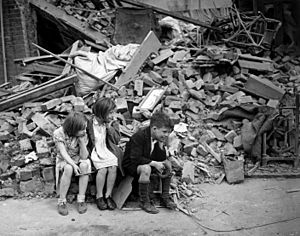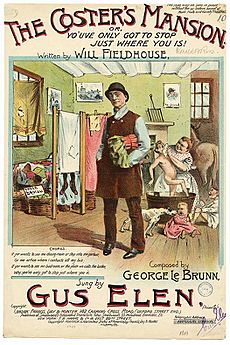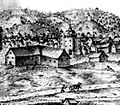East End of London facts for kids
The East End of London, often called simply the East End, is a historic part of East London. It lies east of the old Roman and medieval walls of the City of London and north of the River Thames. Its exact northern and eastern borders are not always clear, but the River Lea is often seen as the eastern edge. Some parts of the East End are even considered to be in Central London. People sometimes say "East of Aldgate Pump" to mean this area.
The East End started to grow in the Middle Ages, slowly at first, outside the city walls. This growth sped up a lot in the 1800s, taking in older villages. The first time the East End was mentioned as a separate place was in 1720 by John Strype. He described London as having four parts: the City of London, Westminster, Southwark, and "That Part beyond the Tower." This reference to the Tower was important because the East End was part of an area called the Tower Division. This area had always provided soldiers for the Tower. As London grew, the Tower Division became known as the wider East London, before London expanded even further, past the River Lea into Essex.
This area was known for its challenges, like poverty and crowded living. This led to a history of strong community action and links with important social reformers who worked to improve things. Another big part of East End history is migration, with people moving both into and out of the area. Many poor people from other parts of England came here. Waves of people also arrived from further away, like Huguenot refugees, Irish weavers, Ashkenazi Jews, and in the 1900s, people from Sylhet.
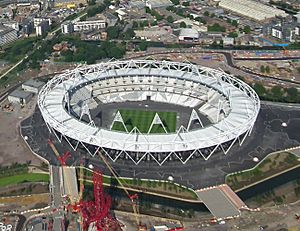
The last of the Port of London's East End docks closed in 1980. This created new problems but also led to efforts to rebuild and improve the area. Canary Wharf and the Olympic Park are two very successful examples of this. While some parts of the East End are changing quickly, the area still faces some of Britain's biggest challenges with poverty.
Contents
Where is the East End?
The East End is located east of the old Roman and medieval walls of the City of London and north of the River Thames. Aldgate Pump, on the edge of the City, is often seen as the symbolic starting point of the East End. Along the river, the Tower Dock inlet, just west of the Tower of London and Tower Bridge, marks the start of the modern London Borough of Tower Hamlets.
Beyond these points, the East End doesn't have official or widely agreed-upon borders. People have different ideas about how much of wider East London is included.
The area starts where the old city walls ended. It includes the small, old City areas of Bishopsgate Without and the Portsoken. The different channels of the River Lea are sometimes considered the eastern boundary.
Some people define the East End very narrowly, only including the modern London Borough of Tower Hamlets. More commonly, people add the old area of Shoreditch (which includes Hoxton and Haggerston), now the southern part of the London Borough of Hackney. Other people prefer an even wider definition, including places like West Ham, East Ham, Leyton, Walthamstow, parts of Hackney, and Ilford.
The broader East London area might include the two eastern wards of the City, the former Tower Division, and parts of London east of the Lea.
How the East End Grew
Early Days
The East End grew along the Thames and outside the gates of Bishopsgate and Aldgate. These gates, built with the city wall, allowed old roads (now the A10 and A11/A12) to enter the walled city. The walls limited growth, so the gates were very important in shaping the areas outside the city.
The walled City was built on two hills, separated by the Walbrook river. The western side was busier and richer, with the cathedral and a large market for land-based trade. The eastern side was poorer and less populated. Its smaller market was near the river for sea trade. These differences inside the walls continued to influence how the areas outside the walls developed.
The land outside the walls was divided into areas before the Domesday Book. The land outside Aldgate was held by the Cnichtengild, a group that defended Aldgate and the walls. The land around Bishopsgate was likely managed by the Bishop of London, who encouraged building in the less developed eastern part of the walled city. Most of the rest of the area was part of the Bishop of London's Manor of Stepney. This Manor's lands later formed the Tower Division, or Tower Hamlets, which stretched north to Stamford Hill. It's believed the Bishop held this land because of his duty to maintain and guard the Tower of London.
These land divisions became the basis for the old parishes and City Wards. Over time, these developed into the administrative areas we see today.
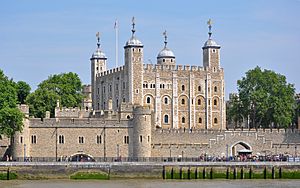
Five religious institutions, which were centers for learning and charity, were built just outside the walls. These included Bedlam, Holywell Priory, The New Hospital of St Mary without Bishopsgate, the Abbey of the Minoresses of St. Clare without Aldgate, Eastminster near the Tower, and St Katherine's on the Thames.
Bromley had St Leonards Priory. Barking Abbey, an important religious center since Norman times, was where William the Conqueror first set up his English court. Further east, the Cistercian Stratford Langthorne Abbey became the court of Henry III in 1267. It was the fifth largest Abbey in the country. Edward I held his parliament in Stepney in 1299.
The lands east of the City were sometimes used as hunting grounds by bishops and royalty. Henry VIII had a hunting lodge at Bromley Hall.
The number of people living in the countryside here grew a lot in the Medieval period. Even with setbacks like the Black Death, the area had a thriving mixed economy. This led to large settlements, mostly of tradesmen, growing along the main roads, like Mile End and Bow. These settlements would later expand and join with London itself.
Growth and Character
Geography played a big role in shaping the East End. The wind usually blows from west to east, just like the river flows. This meant that industries that caused pollution or bad smells tended to be built in the east.
Metalworking was done between Aldgate and Bishopsgate in the 1300s. Shipbuilding for the navy was recorded at Ratcliff in 1354. By 1485, ships were being fitted and repaired in Blackwall. A major fishing port grew downstream at Barking. These factors meant that industries related to building, repairing, and supplying ships grew in the area.
Growth was much slower in the east compared to the large western suburbs. The eastern suburbs were separated from the northern parts by Moorfields, an open, marshy area near the city wall. Moorfields remained open until 1817. This open space helped create the different economic character of the areas and the idea that they were separate.
Building sped up in the late 1500s. By 1603, John Stow described the crowded riverside area, which had grown a lot in his lifetime.

In 1676, Sir William Petty noted how polluted the area was. He suggested London's center should move west, away from "the fumes steams and stinks of the whole easterly pyle."
In 1720, John Strype first described the East End as a distinct place. He said London had four parts: the City, Westminster, Southwark, and "That Part beyond the Tower."
The Tower of London was important here. The East End was the urban part of the Tower Division. This area had a long history of providing military service to the Constable of the Tower. This made the Constable a powerful figure in the early East End. Later, as London grew, the Tower Division became known as wider East London.
The difference between the East and West Ends was very clear. In 1797, the writer Archenholz wrote that the East End had "old houses, the streets there are narrow, dark, and ill paved; inhabited by sailors and other workmen... and by a great part of the Jews." He called the contrast with the West End "astonishing."
Around 1800, Rev. Richardson noted that people from the far east of London knew nothing about the western parts, and vice-versa. He said there was "little communication or sympathy between the two ends of London."
The East End has always had some of London's poorest areas for several reasons:
- An old land ownership system meant there was little reason to build good quality homes.
- Polluting industries, like tanning, were placed in the East End. This was because the wind usually blew from west to east, carrying bad smells away from the rest of the city.
- Jobs in the docks and related industries often paid low wages and involved unstable work.
- The royal court and government were in Westminster, on the opposite, western side of the City.
In medieval times, trades were done in workshops in the City. By 1666, these were becoming industries. Some were noisy or needed lots of space, like drying clothes in fields. Others were dangerous, like making gunpowder. These activities moved outside the City walls to the East End.
In 1817, Moorfields was built on, closing the gap with Finsbury. In the late 1800s, development across the Lea into West Ham began.
Over time, large land estates were broken up, allowing for more development. Fine houses for captains and merchants began to be built. Samuel Pepys moved his family to Bethnal Green during the Great Fire of London. Captain Cook moved to Stepney Green. Mile End also got some fine buildings.
By 1882, Walter Besant described East London as its own city, due to its large size and separation from the rest of the capital.
Fast Growth in the 1800s
As the area became more built up and crowded, wealthy people sold their land and moved further away. In the 1700s and 1800s, there were still efforts to build nice houses, like Tredegar Square (1830). The open fields around Mile End New Town were used to build homes for workers in 1820.
Globe Town was created from 1800 to house the growing number of weavers around Bethnal Green. Bethnal Green's population tripled between 1801 and 1831. By 1824, many looms were idle due to relaxed rules on French silk imports. With many warehouses already there, the cheap labor was used for making boots, furniture, and clothes.

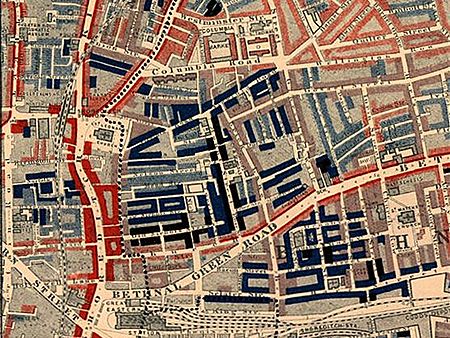
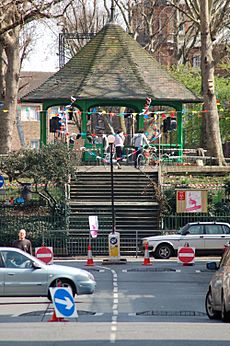
During the 1800s, building couldn't keep up with the growing population. Henry Mayhew visited Bethnal Green in 1850 and wrote that roads were unmade, houses were small, and there was a lack of drainage. He noted "Pigs and cows in back yards, noxious trades... and 'lakes of putrefying night soil' added to the filth."
A movement began to clear these run-down areas. Laws were passed to allow authorities to take over poor housing and build new homes. Groups like the Peabody Trust were formed to provide housing for the poor. Railway companies also demolished many old homes. The Housing of the Working Classes Act 1890 gave local councils new powers. This led to the building of new housing like Blackwall Buildings.
By 1890, official programs to clear run-down areas had started. This included creating the world's first council housing, the LCC Boundary Estate. This replaced the crowded streets of Friars Mount, known as The Old Nichol Street Rookery. Between 1918 and 1939, the LCC continued to replace East End housing with five- or six-story flats. The Second World War stopped further clearance.
Industry and New Ideas
Industries related to the sea grew throughout the East End, including rope making and shipbuilding. You can still see where roperies were from the long, narrow streets, like Ropery Street near Mile End. Shipbuilding for the navy was recorded at Ratcliff in 1354. On January 31, 1858, the largest ship of its time, the SS Great Eastern, designed by Isambard Kingdom Brunel, was launched from Millwall. This huge ship had to be launched sideways. After this, shipbuilding on the Thames slowly declined. Ships continued to be built at the Thames Ironworks and Shipbuilding Company until it closed in 1913.
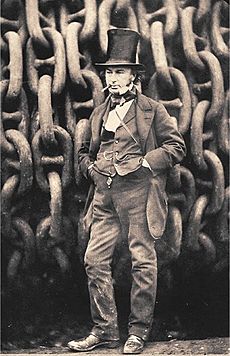
East of the Tower of London are six and a half miles of former docklands. The most central docks, just east of the Tower, are St Katharine Docks, built in 1828 for luxury goods. They were not very successful for large ships.
The London Docks were built in 1805. The soil from their construction was used to build up the marshy area of Pimlico in west London. These docks imported tobacco, wine, and wool into guarded warehouses. They could hold over 300 sailing ships. They closed in 1971, as they couldn't handle modern ships.
The West India Docks were built in 1803, providing berths for larger ships. Produce from the West Indies was unloaded directly into warehouses. The old Brunswick Dock became the basis for the East India Company's East India Docks in 1806. The Millwall Docks were created in 1868, mainly for importing grain and timber.
The first railway, the "Commercial Railway", was built in 1840. It ran from Minories to Blackwall. The building of London train stations at Fenchurch Street (1841) and Bishopsgate (1840) gave access to new suburbs across the River Lea. This also led to more crowded conditions in the existing poor areas. After Liverpool Street station opened in 1874, Bishopsgate became a goods yard. It closed after a fire in 1964 and was demolished in 2004.
The Metropolitan Building Act of 1844 led to growth across the Lea into West Ham. This Act restricted dangerous industries from the main city area, so many moved to the river banks. The building of the Royal Docks (1855, 1880, 1921) on the marshy estuary helped London's development spread across the Lea into Essex. Railways gave access to a passenger terminal at Gallions Reach and new suburbs in West Ham. West Ham quickly became a major manufacturing town. Soon after, East Ham was built to serve the new Gas Light and Coke Company and Bazalgette's sewage works at Beckton.
Between 1885 and 1909, Walthamstow saw many transport innovations. In 1885, John Kemp Starley designed the first modern bicycle. In 1892, Frederick Bremer built the first British motorcar. The London General Omnibus Company built the first mass-produced buses there from 1908. In 1909, A V Roe tested the first all-British airplane on Walthamstow Marshes.
Decline and Rebuilding
The East End has historically had poor housing and facilities. From the 1950s, the area faced big changes as the UK economy changed. The closing of docks, railway cutbacks, and loss of industries led to a long period of decline. Many traditional low-skilled jobs disappeared.
The docks declined from the mid-1900s, with the last ones closing in 1980. London's main port facilities are now further downstream at Tilbury and London Gateway. These larger, modern facilities can handle today's huge container ships.
There has been a lot of rebuilding, and the East End has become a desirable place for businesses. However, much of this development has not directly helped local communities. It has caused property prices to rise, meaning many parts of the area are still among the poorest in Britain.
New Homes
The area used to have a very high number of council homes, built after old housing was cleared and after wartime damage. Many of the tall apartment blocks from the 1960s have been taken down or updated. They are being replaced by lower-rise housing, often privately owned or managed by housing associations.
Better Transport
By the mid-1980s, the District line and Central line were too crowded. The Docklands Light Railway (1987) and Jubilee line (1999) were built to improve train travel in the area.
Road links were improved by the Limehouse Link tunnel (1993) and the extension of the A12 to connect to the Blackwall Tunnel in the 1990s. The extension of the East London line brought more improvements in 2010. From 2021, the Elizabeth Line will create a new east–west train service across London, with a major station at Whitechapel. New river crossings are also planned.
City Fringe Rebuilding
The strong financial sector in the City of London has led to many large office buildings being built around the City's edge. This has helped local businesses. The area around Old Spitalfields Market has been redeveloped. Brick Lane, known as London's curry capital, has also benefited from the City's success.
Art galleries have grown, including the expanded Whitechapel Gallery. The area around Hoxton Square has become a center for modern British art, with many artists living and working there. This has made Hoxton and Shoreditch fashionable, with a busy nightlife. However, many long-time residents have been forced to move due to higher property prices.
East London Tech City, a group of technology companies, has grown in Shoreditch. Queen Mary University of London has expanded its campus at Mile End and opened medical campuses at the Royal London Hospital and Whitechapel.

Canary Wharf and Docklands Rebuilding
The closing of the docks and related industries led to the creation of the London Docklands Development Corporation (1981-1998). This group worked to encourage economic growth.
Because of this and new transport links, many urban renewal projects have happened. The most notable is Canary Wharf, a huge business and housing development on the Isle of Dogs. Another big development is London City Airport, built in 1986 in the former King George V Dock. There has also been a lot of building of luxury apartments, mainly around the old dock areas and along the Thames.
The Docklands rebuilding has been successful. However, since it focuses on service industries, the jobs don't always match the skills of the local communities.
Stratford Rebuilding
The 2012 Summer Olympics and Paralympics were held in the Olympic Park. This park was built on old industrial land around the River Lea. The park now has new sports facilities, housing, and other infrastructure to help the area continue to grow. Other developments in Stratford include Stratford International station and the Stratford City development. The University of East London also built a new campus nearby.
People of the East End
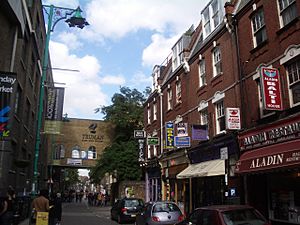
Cities have historically needed people to move in to keep their population levels up. People moving into the East End have helped its population grow. In turn, many East Enders have moved to other areas.
People Moving In
The way people speak in the East End, known as Cockney, shows influences from the old Essex dialect. This suggests that many early Londoners came from Essex and nearby eastern areas. People from all over Britain have made the East End their home. Migration from other countries has also always brought new East Enders. As early as 1483, the Portsoken area had more "aliens" (foreigners) than any other part of the City of London.
Immigrant communities mainly settled along the river. From the Tudor era until the 1900s, ship crews were hired casually. Sailors from the Indian subcontinent and Africa formed communities. Chinatowns in Shadwell and Limehouse grew as Chinese people moved to London. After World War II, this community moved to Soho.
Weaving was a big industry in areas near the City but away from the Thames. Many Huguenot (French Protestant) refugees, who were weavers, came to Spitalfields and western Bethnal Green in the 1600s.
In 1786, a group was formed to help London's "black poor." Many of these were former slaves who had fought for the British in the American War of Independence. Others were sailors or freed slaves from British colonies. This group helped people find work and even funded an expedition to settle in Sierra Leone in west Africa. From the late 1800s, a large African sailor community grew in Canning Town.
In 1655, Cromwell allowed Jews to resettle in England. The East End became the main center for Jews in England. In the 1870s and 1880s, many Jewish people arrived, leading to over 150 synagogues being built. Today, four active synagogues remain in Tower Hamlets. Jewish immigration to the East End peaked in the 1890s. In the mid and late 1900s, many Jews moved to richer areas in the eastern suburbs and north London.
From the late 1950s, the local Muslim population grew due to more immigration from the Indian subcontinent, especially from Sylhet in East Pakistan. These migrants settled in areas where Sylheti communities already existed, working in the docks and Jewish tailoring shops. In the 1970s, this immigration increased a lot. Today, Bangladeshis are the largest minority in Tower Hamlets, making up 32% of the borough's population in 2011. The East London Mosque was moved to a new building in 1985 and can now hold 7,000 people.
Newcomers and minorities have sometimes faced hostility. In 1517, the Evil May Day riots saw attacks on foreign-owned property. The anti-Catholic Gordon Riots of 1780 started with burning Catholic homes in Poplar and Spitalfields.
In the 1900 General Election, Major Evans-Gordon became an MP for Stepney by promising to limit immigration. He claimed that "not a day passes but English families are ruthlessly turned out to make room for foreign invaders." This campaign led to the Aliens Act 1905, which gave the government powers to control immigration.
On October 4, 1936, thousands of fascists, led by Oswald Mosley, tried to march through the East End. Up to 100,000 East Londoners came out to oppose them. This led to clashes between the fascists, their opponents, and the police. These events, known as the Battle of Cable Street, forced the fascists to abandon their march.
People Moving Out: The Cockney Diaspora
As London grew east, East Enders often moved to new suburbs for opportunities. The late 1800s saw many people move to West Ham and East Ham to work in the new docks and industries there.
There was a lot of work to reduce crowded housing from the early 1900s. Between the World Wars, people moved to new housing estates built for this purpose, especially at Becontree and Harold Hill, or left London entirely.
The Second World War badly damaged much of the East End. Its docks, railways, and industries were constant targets for bombing, especially during the Blitz. This led to people moving to new suburbs and new housing being built in the 1950s. Many East Enders moved even further, leaving London completely, often to the Essex new towns of Basildon and Harlow.
The population decline sped up after World War II. It has only recently started to reverse. However, the Bangladeshi community, now the largest in Tower Hamlets, is also starting to move to the eastern suburbs. This shows improved economic situations, and this latest group of migrants is following a pattern seen for over three centuries.
Here are the population figures for the area that now forms the London Borough of Tower Hamlets:
| Borough | 1811 | 1841 | 1871 | 1901 | 1931 | 1961 | 1971 | 1991 | 2001 | 2011 |
|---|---|---|---|---|---|---|---|---|---|---|
| Bethnal Green | 33,619 | 74,088 | 120,104 | 129,680 | 108,194 | 47,078 | n/a | n/a | n/a | n/a |
| Poplar | 13,548 | 31,122 | 116,376 | 168,882 | 155,089 | 66,604 | ||||
| Stepney | 131,606 | 203,802 | 275,467 | 298,600 | 225,238 | 92,000 | ||||
| Total | 178,773 | 309,012 | 511,947 | 597,102 | 488,611 | 205,682 | 169,626 | 161,064 | 196,106 | 254,100 |
For comparison, the population of England and Wales was 9 million in 1801. By 1851, it had more than doubled to 18 million. By the end of the century, it reached 40 million.
Culture and Community
Cockney Identity
Even with a sometimes negative image from outsiders, people from the East End are proud of their area and their Cockney identity. The term Cockney has loose definitions related to geography and language. In reality, people from all over the East End, and even wider East London, identify as Cockneys. Some use the Cockney dialect, and others do not.
A traditional definition says that to be a Cockney, you had to be born within the sound of Bow Bells. These bells are on Cheapside, within the old city walls, so technically outside the East End. The flat land and strong winds in the East End meant the sound of the bells could travel far to the east. In the 1800s, the sound could be heard as far as Stamford Hill, Leyton, and Stratford. Today, noise pollution means the bells can only be heard as far as Shoreditch.
The Cockney dialect has words borrowed from Yiddish, Romani, and costermonger slang. It has a special accent that includes dropping 't' sounds and using rhyming slang. The accent is thought to be an old form of London speech, strongly influenced by the traditional Essex dialect, and changed by the many immigrants to the area. Cockney English is spoken widely in the East End and other working-class areas across London.
The Cockney dialect in London has become less common because of the rise of Received Pronunciation (RP) (a standard British accent) and the large number of people moving to London. However, people moving out of East London have spread the Cockney dialect beyond the capital.
By tradition, any child born at sea was considered a parishioner of Stepney (which once covered most of the East End). They could claim help there. This maritime link is remembered in the old rhyme:
He who sails on the wide sea, is a parishioner of Stepney
Bells
In 1360, Geoffrey Chaucer, who lived in the City Wall's Aldgate gatehouse, noted that bell-founding was already an industry outside the wall in the Aldgate/Whitechapel area.
Two of the six sets of bells in the nursery rhyme Oranges and Lemons are in the East End (Whitechapel and Shoreditch). The famous Bow Bells (at St Mary-le-Bow on Cheapside) are a symbol of the East End, even though they are technically outside it.
The Whitechapel Bell Foundry opened in 1570. Until it closed in 2016, it was the oldest manufacturing company in the UK. The foundry made many famous bells, including Big Ben, the Liberty Bell in Philadelphia, and Bow Bells. Other Whitechapel bells in the area include those at St Dunstan's in Stepney and the churches of West Ham and Hackney. The Olympic Bell at the London Stadium, the largest harmonically tuned bell in the world, was made by Whitechapel and a Dutch foundry.
St Dunstan and Stepney
Dunstan was a church leader, statesman, and saint in the 900s with strong ties to the East End. As Bishop of London, he was also the Lord of the Manor of Stepney, which included most of what would become the East End.
In 952, Dunstan is recorded as founding or rebuilding St Dunstan's Church in Stepney. This was originally the only church for the Parish of Stepney, which covered much of the East End. Because of this, St Dunstan's is known as The Mother Church of the East End. Dunstan is the closest the East End has to a patron saint. He is also the patron saint of bell ringers and metalworkers. His feast day is May 19.
Dunstan's connection to the area led to his fire-tong symbol being included in the coat of arms of the Metropolitan Borough of Stepney and its successor, the modern London Borough of Tower Hamlets.
Brick Lane Mosque
Throughout its history, the East End has changed a lot due to economic and social shifts, including migration. The Brick Lane Mosque is a great example of this.
The building was first a church, built by Huguenot Protestant refugees who came to East London to escape persecution. After many of them moved away, it became a Methodist chapel for a wider Christian community. Later, it became a synagogue, used by Jewish people who came to avoid persecution in Europe. As the Jewish community in the area became smaller, the building was taken over by the local Bengali community in 1976 and is now used as a mosque.
Weaving and Mulberries
The importance of the textile industry to the East End is shown by the inclusion of a sprig of Mulberry in the Coat of Arms of the London Borough of Tower Hamlets. Many of the borough’s staff uniforms are Mulberry colored, and the Town Hall is named Mulberry Place.
The Bethnal Green mulberry tree, believed to be the oldest tree in the East End, was saved from developers after a long community campaign.
Military Contribution
The Tower Division (also known as the Tower Hamlets) was a part of Middlesex, but it managed its own reserve forces. It was independent of the Lord Lieutenant of Middlesex, having its own Lord Lieutenant, the Constable of the Tower. The Tower Hamlets men, or Hamleteers, helped the Tower of London's small Yeoman Warder garrison. The first record of this service dates to 1554, but it describes older duties.
Local forces continued to be mainly based on the Tower Division until it was abolished in 1900. However, Tower Hamlets units remained part of the army until 1967.
Sport
There are three professional football clubs in the East End area: West Ham United, Leyton Orient, and Dagenham and Redbridge. Leyton Orient and West Ham have roots in maritime trades. West Ham started as the works team of the Thames Ironworks. Dagenham and Redbridge was formed by merging four clubs from East London.

There are not strong rivalries between these three clubs. However, the rivalry between West Ham and Millwall is one of the fier fiercest in English football. Millwall started in the Isle of Dogs but moved to Deptford, South London in 1910. The rivalry is known as the Dockers Derby, as both clubs traditionally got support from the dockyards on either side of the Thames.
In 1966, three West Ham players (Bobby Moore, Martin Peters, and Geoff Hurst) were key players when England won the World Cup. West Ham's anthem, I'm Forever Blowing Bubbles, was used in the 2012 Olympic Opening Ceremony.
Pearlies
The Pearly Kings and Queens, or pearlies, are a traditional part of London costermonger culture. Their name comes from their clothes, which are decorated with mother-of-pearl buttons.
The pearlies were originally chosen by costermongers to protect their rights. Now, they are fully dedicated to charity work. Pearlies are part of the East End's heritage, but they are not only found in the East End. There are Pearly Kings and Queens across inner London. A parade of real-life Pearly Kings and Queens was featured at the 2012 Summer Olympics Opening Ceremony.
Wars and Conflict
The East End has seen several conflicts, in addition to actions involving the Tower of London and its garrison.
Roman Era Massacre
Blomfield Street, on the western edge of Bishopsgate Without, covers part of the Walbrook River. Many Roman-era skulls have been found on the riverbed in this area. Most theories suggest these skulls are from a massacre of prisoners after a Roman conflict.
Wars of the Roses
In 1471, Edward IV had won the Battle of Barnet and imprisoned his rival, Henry VI, in the Tower of London. While Edward was away, Bastard Fauconberg raised armies in Kent and Essex. They attacked London to try and free Henry from the Tower.
Fauconberg tried to cross London Bridge and also attacked the eastern gates with thousands of men and artillery. Breweries and pubs in the eastern suburb of St Katherines were ransacked and set on fire.
Bishopsgate was set on fire, and the attackers almost captured Aldgate. The gate was breached, and attackers started to pour through. However, a portcullis (a heavy gate) was dropped, killing some and trapping others who had passed through. These trapped attackers were then killed by the defenders.
Troops from the Tower garrison came out and attacked the besiegers from the side. A counter-attack was also launched from inside the gate. The attackers were defeated and chased, with many casualties.
Battle of Bow Bridge
In June 1648, during the Second English Civil War, Royalist forces crossed from Greenwich to Poplar. They hoped to join other Royalists in Essex. The Royalists were met by the Tower Hamlets Militia and other Parliamentarian forces. A series of small battles happened at and around Bow Bridge.
After the battle, the Royalists went to Colchester, which was held by Royalists. This led to the ten-week Siege of Colchester, which Parliament won.
First World War
The first bomb of the first air raid on London fell on West Hackney on May 31, 1915. It was the first time the capital had been attacked by a foreign enemy since 1066. The raid killed seven people across London. East London was especially at risk during early attacks because the Kaiser had ordered raiders to target areas east of the Tower of London.
Airship raids continued until 1917, followed by airplane raids in 1917-18. The first daylight attack by German Gotha aircraft on June 13, 1917, killed 104 people, including 18 at Upper North Street School in Poplar. During the war, 120 children and 104 adults were killed in the East End by bombs.
The largest single loss of life was from an industrial accident. On January 19, 1917, 73 people died, and over 400 were injured, in a TNT explosion at a factory in Silvertown. Much of the area was destroyed. The explosion was heard as far away as Southampton and Norwich.
Second World War
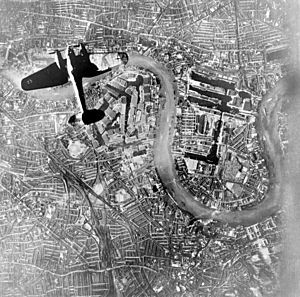
Initially, German commanders did not want to bomb London. On August 24, 1940, a single aircraft accidentally bombed Stepney, Bethnal Green, and the City. The RAF retaliated by bombing Berlin. The Luftwaffe then changed its strategy to attack cities. The East End and docks were a main target. The first big raid happened at 4:30 p.m. on September 7, with 150 bombers. Silvertown and Canning Town were hit hardest.
Between September 7, 1940, and May 10, 1941, there was continuous bombing, known as "the Blitz". East London was targeted because it was a center for imports and war materials. On the first night of the Blitz, 430 civilians were killed. People responded by sending children away and building shelters. On September 10, 1940, 73 civilians were killed when a bomb hit South Hallsville School in Canning Town.
The intense bombing worried authorities. Winston Churchill himself toured the bombed areas of Stepney and Poplar. Anti-aircraft guns were built in public parks and along the Thames.
Authorities were at first hesitant to open the London Underground for shelter. On September 12, after five days of heavy bombing, people in the East End took matters into their own hands. They went into Liverpool Street Station with pillows and blankets. The government then allowed the partially completed Central line to be used as a shelter.
On March 3, 1943, at 8:27 p.m., the unopened Bethnal Green Underground station was the site of a disaster. Families had crowded into the station. A woman slipped on the stairs, and 173 people died in the resulting crush. The truth was hidden at first. There is now a plaque at the station entrance and a larger memorial nearby. The first V-1 flying bomb struck in Grove Road, Mile End, on June 13, 1944, killing six people.
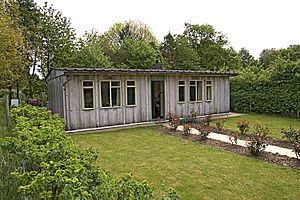
By the end of the war, 80 tons of bombs had fallen on Metropolitan Borough of Bethnal Green alone. In Bethnal Green, 555 people were killed. For all of Tower Hamlets, 2,221 civilians were killed, and 7,472 were injured. 46,482 houses were destroyed. When Buckingham Palace was hit, Queen Elizabeth said, "It makes me feel I can look the East End in the face." By the end of the war, the East End was devastated. Many prefabricated houses were built in bombed areas. Today, housing estates from the 1950s and 1960s dominate the area.
How the East End is Seen
Reputation
Society often viewed the East End with a mix of suspicion and interest. The term "East End" began to be used negatively in the late 1800s. This was when London's population grew, leading to extreme overcrowding and many poor people and immigrants. The problems got worse when new docks and railway stations were built, clearing old crowded areas and forcing many displaced people into the East End. Over a century, the East End became known for poverty, overcrowding, and crime.
Jack London visited London in 1902 and found that his taxi driver claimed not to know the way to the East End. London wrote that even "Thomas Cook and Son, path-finders and trail-clearers... knew not the way to the East End." This showed how separate the East End was seen.
Popular Culture
The East End has been the subject of many studies and books since the 1800s, like Henry Mayhew's London Labour and the London Poor (1851) and Charles Booth's Life and Labour of the People in London. Arthur Morrison's novel A Child of the Jago (1896) is set in Bethnal Green. Jack London wrote about his experiences in The People of the Abyss (1903). George Orwell also wrote about his time there in Down and Out in Paris and London.
These studies and stories have explored themes like crime, poverty, class differences, and meeting different cultures.
The image of the East Ender changed a lot between the 1800s and 1900s. In the 1870s, they were often shown as lazy or untrustworthy. However, many East Enders worked in honest jobs like carters and costermongers. These costermongers became popular in music hall songs around 1900, with performers like Marie Lloyd and Gus Elen creating the image of the funny East End Cockney. This image, supported by strong family ties and the community's strength during the war, appeared in books and films.
The success of Jennifer Worth's book Call the Midwife (2002), which became a best-seller and a popular BBC show, led to a lot of interest in real-life stories from the East End. Many similar books were published in the 2000s. Authors noted that many East Enders were unhappy with how their neighborhoods had been shown in books and on screen – as dirty and criminal. So, they wanted to show the positive sides of East End life and community.
The popular British TV show EastEnders is set in the East End.
Images for kids
-
Curtain Theatre, c. 1600 (some sources identify this as a depiction of The Theatre, the other Elizabethan theatre in Shoreditch)
-
1867 Poster from the National Standard Theatre, Shoreditch
See also
 In Spanish: East End de Londres para niños
In Spanish: East End de Londres para niños



